Making
one good microscope out of 3
by
Bill Resch, USA
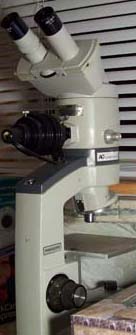 During
this long Minnesota winter I had to find something fun to do. I
noticed this old American Optical frame sitting in my basement. It is
from a "Radius Scope", designed to measure contact lenses.
Somebody gave it to me years ago. It did not have a stage. I made one
a while ago from some aluminum stock. I never used the instrument.
The illumination was from the top through a 4X objective (the only
one). My stereo scope did a better job viewing subjects from the top.
During
this long Minnesota winter I had to find something fun to do. I
noticed this old American Optical frame sitting in my basement. It is
from a "Radius Scope", designed to measure contact lenses.
Somebody gave it to me years ago. It did not have a stage. I made one
a while ago from some aluminum stock. I never used the instrument.
The illumination was from the top through a 4X objective (the only
one). My stereo scope did a better job viewing subjects from the top.
I had to
do something with this instrument to make it usable.
I went on
eBay and found several AO microscopes at a very low price. I bought
an American Optical 160. It had 3 objectives, a mechanical stage and
an illuminator in the base, which was just a bulb behind a ground
glass. I got it for only $47. It did have a broken revolving nose
piece. The ball bearings were missing. It was just hanging in there
loosely. But the nose piece itself was fine. It was a four objective
nose piece. I fitted it to the Radius Scope. Now I had a four
objective microscope.
I wanted a
better illuminator. So I went on eBay again and found an AO 150 for
$15. No optics, but it had a low voltage halogen illuminator with
intensity control. There was also a lens after the ground glass. Not
Köhler, but better than the 160. It also had a focusable substage
condenser with diaphragm and filter holder. All the items a hobbyist
likes.
There was
one problem though: Somebody must have dunked the whole thing in oil.
I had to do a lot of cleaning. The hard part was the diaphragm. The
oil was so heavy, I could not open or close it. I overcame my fear
and took it apart. I cleaned the blades with automotive break
degreaser. That stuff is effective.
Putting
the diaphragm back together was another story. I tried all kind of
ways. I checked past "Micscape" articles. That helped a
little, but I had a different brand. I finally made a tool to hold
the blades pushed out and held down. With all the blades laid, I
inserted the tool. Now I could move them with a needle until they
dropped into their individual hole. If you ever had one of these
apart, you know what I am talking about.
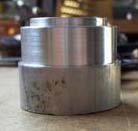 The
tool: I turned it out of 1.5 inch aluminum stock. The diameters are
critical and are given in millimeters.
The
tool: I turned it out of 1.5 inch aluminum stock. The diameters are
critical and are given in millimeters.
This unit
happened to be about 30 mm high. The weight helps to hold the blades
down. The small diameter ring should be polished. It would help, not
to lift the blades up when you remove the tool. When the blades are
all in place, (you can see that on the height of the tool), you can
lay the lever on top and screw it down. Do not oil or grease!
It worked
like a charm after the cleaning and assembly.
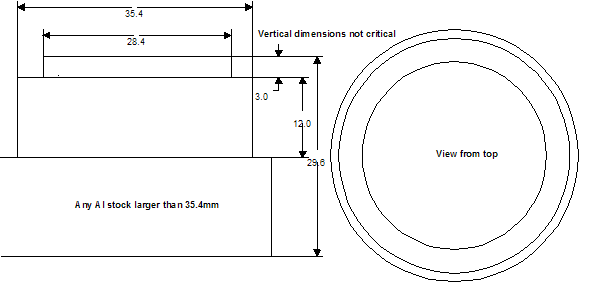
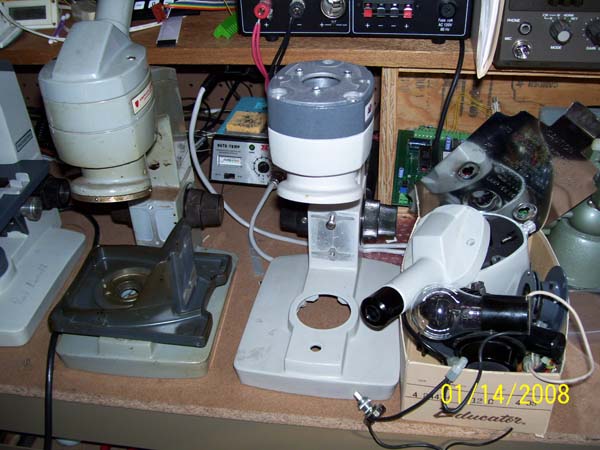
The 150 on
the left and the 160 on the right.
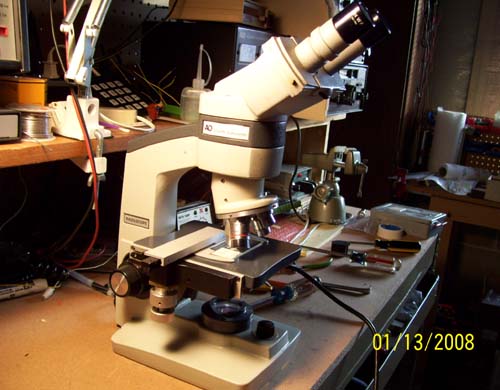
The
finished product.
I had to
test it by taking a photomicrograph. I used a Kodak C653 and held it
against the eyepiece. I zoomed in until there was no more vignetting.
I used a slide from Turtox, labeled: Pleurosigma angulatum. The
objective is the AO 43X NA 0.55. Actually not good enough for this
subject. I could hardly perceive the grid. I was amazed when I
uploaded the picture.
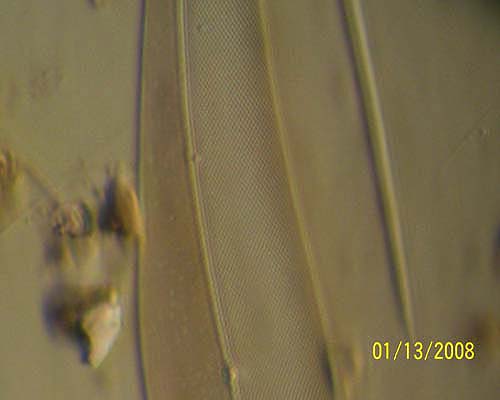
Pleurosigma
angulatum. AO objective 43X, NA 0.55. Right half of condenser
covered.
Final
thought:
I was
impressed with American Optical. Infinity correction objectives 50
years ago, (now everybody is doing it). The focusing mechanism: The
nosepiece is just held down by gravity. No need for springs for
protective retraction in the high power objectives. The focusing
mechanism is virtually wear proof, no maintenance. The objectives I
ended up with are from quite a variety of instruments. Some from
student, some from lab microscopes. There is at least a 20 year
difference in manufacturing time. They all fit, are par focal and
perfectly par centered. That is quality. Too bad, they are out of
this business.
All comments to the author
Bill
Resch
are welcomed.
Microscopy UK Front Page
Micscape Magazine
Article Library
©
Microscopy UK or their contributors.
Published
in the February 2008 edition of Micscape Magazine.
Please
report any Web problems or offer general comments to the
Micscape
Editor
.
Micscape
is the on-line monthly magazine of the Microscopy UK website
at
Microscopy-UK
©
Onview.net Ltd, Microscopy-UK, and all contributors 1995 onwards. All
rights reserved. Main site is at
www.microscopy-uk.org.uk
with full mirror at
www.microscopy-uk.net
.
 During
this long Minnesota winter I had to find something fun to do. I
noticed this old American Optical frame sitting in my basement. It is
from a "Radius Scope", designed to measure contact lenses.
Somebody gave it to me years ago. It did not have a stage. I made one
a while ago from some aluminum stock. I never used the instrument.
The illumination was from the top through a 4X objective (the only
one). My stereo scope did a better job viewing subjects from the top.
During
this long Minnesota winter I had to find something fun to do. I
noticed this old American Optical frame sitting in my basement. It is
from a "Radius Scope", designed to measure contact lenses.
Somebody gave it to me years ago. It did not have a stage. I made one
a while ago from some aluminum stock. I never used the instrument.
The illumination was from the top through a 4X objective (the only
one). My stereo scope did a better job viewing subjects from the top.
 The
tool: I turned it out of 1.5 inch aluminum stock. The diameters are
critical and are given in millimeters.
The
tool: I turned it out of 1.5 inch aluminum stock. The diameters are
critical and are given in millimeters.


